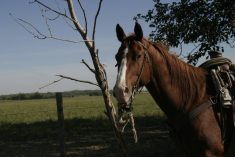In our last edition, AF contributor Madeleine Baerg reported on the status of UHF (ultra-high-frequency) RFID ear tags for the cattle industry. She noted ongoing research by facilities such as SAIT are clearly showing the superior readability and reliability of this ear tag technology compared to the low-frequency (LF) ear tags in use today.
This should be no surprise as that is the usual course of technological development. UHF technology is not exactly new — it’s been used in ear tags for around 10 years. The problem with its earlier implementation, as many in the industry suspect, had more to do with politics, competition and agency foot-dragging. In other words, business as usual, as it is with so many cattle industry issues. However, this technology procrastination is seeing the Canadian livestock industry falling behind other countries. That’s unfortunate as, at one time, we were leaders.
Read Also

A great idea for repurposing grain bins
The Morrison family of southern Alberta have transformed old grain bins into unique guest cabins.
The whole issue, as many might recall, has a tangled history complete with alleged hidden agendas, vested interests, bureaucratic busybody-ness and grandstanding by some politicians. Its genesis goes back to implementing a national cattle ear tag ID program. Although it was controversial back then, that now seems pretty innocent compared to all the intrigues involved in the ongoing traceability initiative. Many of us suspected back then that the National ID program was merely the first step in a much more complex traceability scheme. The example back then was the European livestock passport program, which is a bureaucrat’s dream and a producer’s nightmare. I expect the plan was to use RFID technology to make a Canadian version of the EU animal passport easier and better. Well it started out that way, but it now seems derailed by the technology steamroller.
The present ear tag struggle over which RFID frequency to use started when provincial and federal ministers of agriculture declared they wanted full livestock traceability by an arbitrary date. They threw a bunch of money at the idea to make it so. However, that assumption suddenly brought to light the shortcomings of the present LF RFID frequency being used. It proved to be inadequate and unreliable for the existing speed of commerce. However, that was not the conclusion of the Canadian Cattle Identification Agency (CCIA) and I expect the CFIA (the ID and traceability regulator) and existing LF tag manufacturers wanted to hear, so procrastination set in and more research was demanded.
To be fair, the CFIA had spent considerable time and taxpayer money getting the existing LF RFID program organized to replace the old bar code system. Understandably, officials are in no mood to approve another complete change to a fairly new technology. Tag manufacturers had also invested millions into the system, so they are less than eager to change over again. But the existing LF RFID frequency and technology was unable to shake its shortcomings. Meanwhile, other players were quickly developing UHF technology and proving its superiority. As Baerg reported, UHF tag technology is being embraced by other nations and competitors. That UHF momentum may well see it used as the American livestock industry standard. Global acceptance of UHF would clearly indicate that the LF RFID frequency being used by Canada has become inferior and outdated. No amount of further research and wishful thinking is going to stop ear tag technology progress.
Yet unofficial comments from industry sources imply the CCIA seems to be less than enthusiastic in facing the UHF reality and is dragging its feet in embracing the new technology. Remember this is nothing new, the UHF concept has been around at least 10 years. Tag manufacturers may not be enthused about a wholesale change again, but I expect most are well along with developing UHF tags in order to stay competitive and in the market. Millions are already in use in Brazil and South Korea.
Which brings us to the situation today. The CCIA claims UHF technology has a number of technical problems, UHF proponents dispute that and say further development will resolve any concerns. They also note reliability and readability — the big problems with LF — are completely resolved by UHF. The CCIA brings up retention concerns, which is a bit of a red herring as no tag will ever perfect retention.
It would seem from tag research labs in Calgary and Europe that the focus is on UHF technology and not on preserving old LF technology. Even ALMA has shown its support by investing $500,000 into the SAIT lab. I would suggest there is a message in that — the CCIA and CFIA need to make that big leap forward as it would seem that UHF technology is leaving their present position in the dust.
The livestock industry deserves the best technology available and should be in the forefront. The reality is that if no decision is made soon by the CCIA and CFIA on embracing UHF technology in Canada, I expect our competitors and particularly the U.S. will do it for us.














